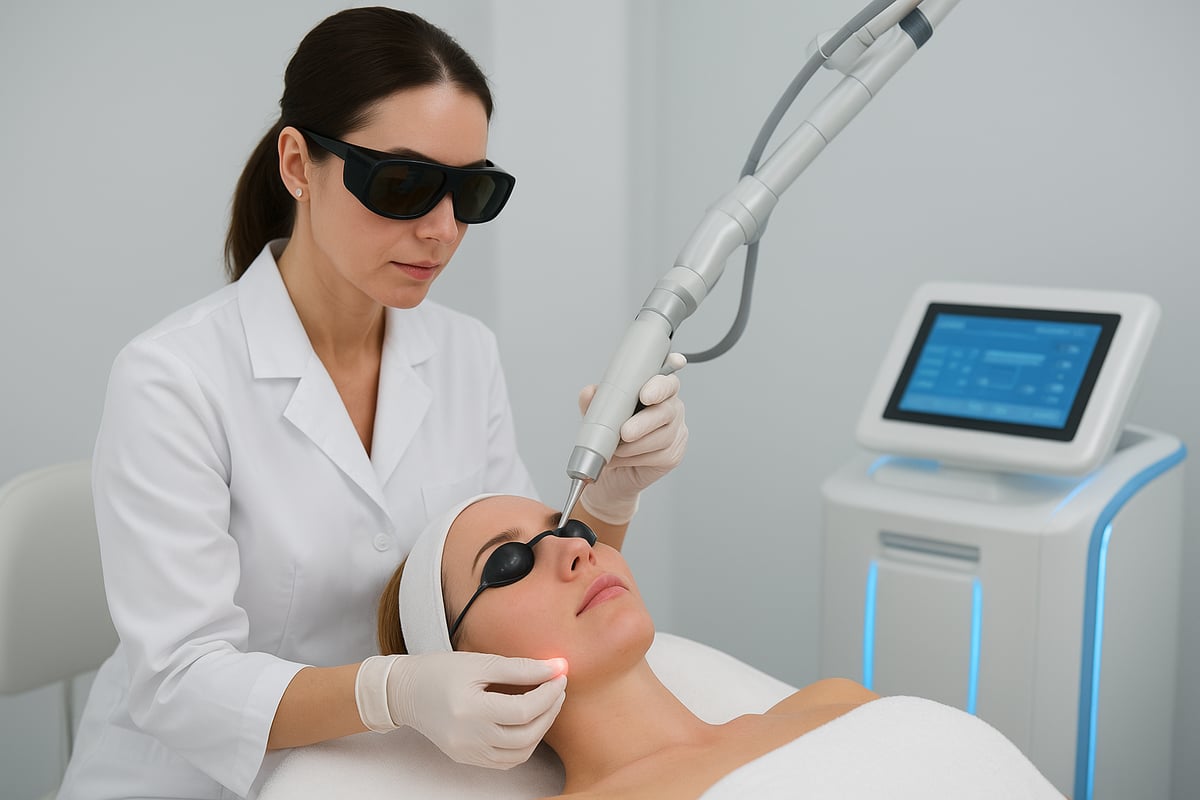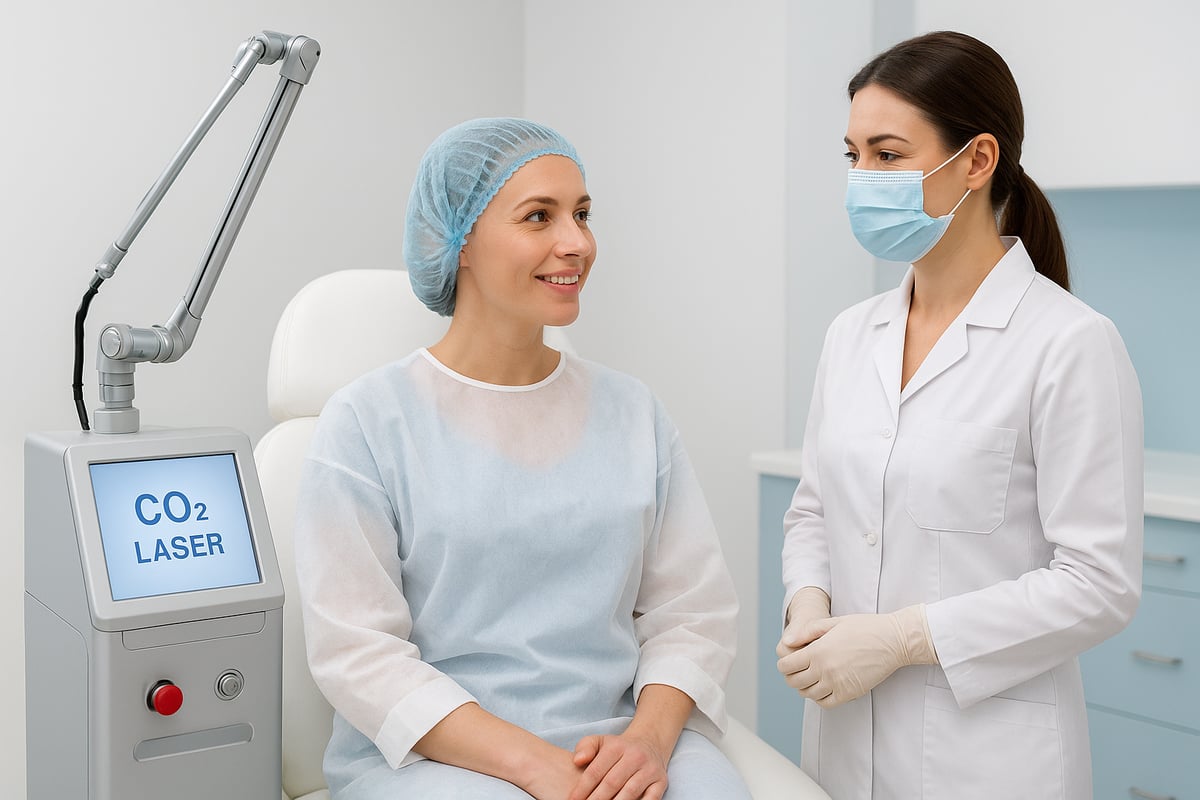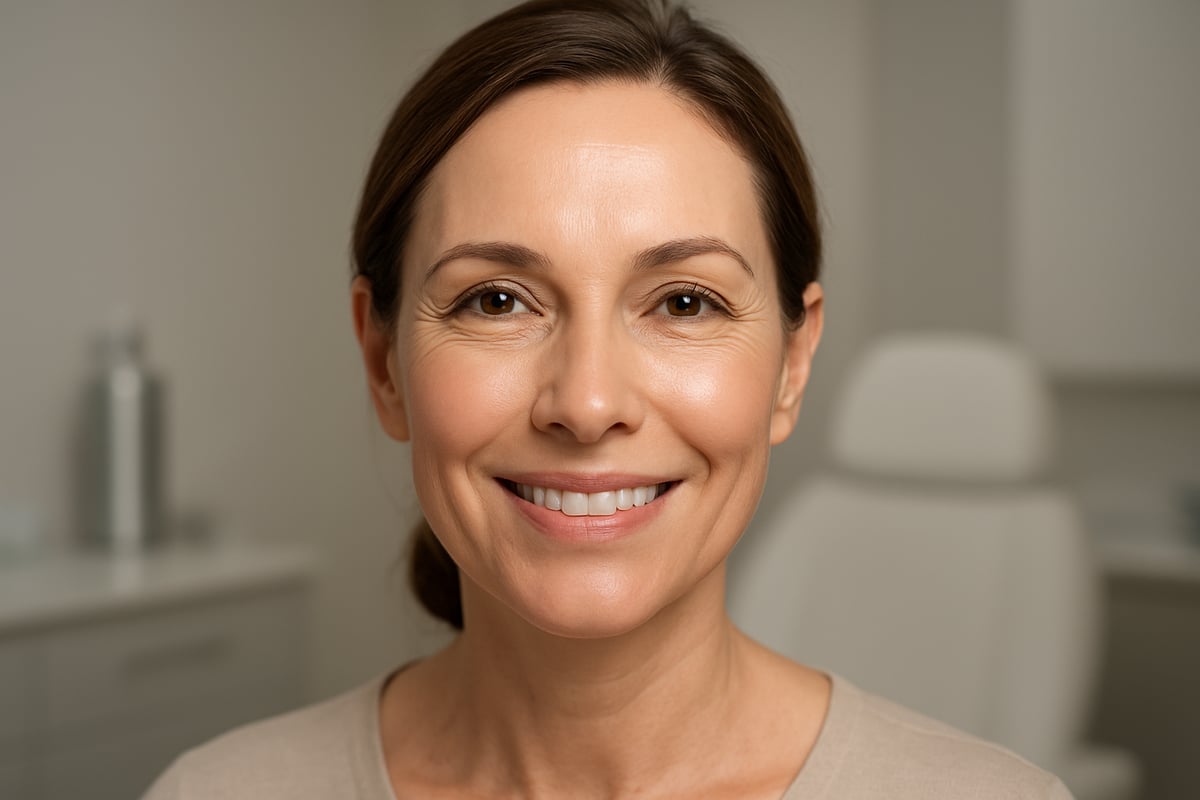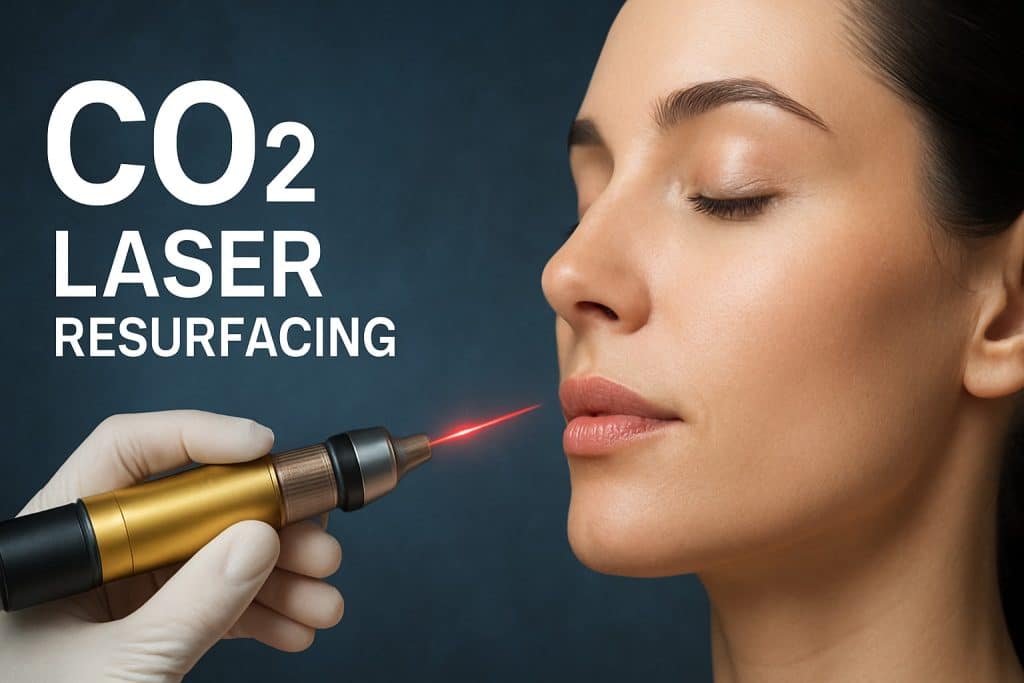Imagine turning back the clock on your skin with a single treatment. In 2025, co2 laser resurfacing is transforming the way we approach aging, sun damage, and scars, delivering results once thought impossible.
This expert guide breaks down everything you need to know about co2 laser resurfacing. You will discover how the technology works, what makes it unique, and the latest innovations making treatments safer and more effective than ever.
Ready to see if advanced skin renewal is right for you? This comprehensive resource will help you make informed, confident decisions about your skin’s future.
Understanding CO2 Laser Resurfacing: Technology and Science
CO2 laser resurfacing is a transformative technology in aesthetic dermatology, first introduced in the 1990s. This procedure uses carbon dioxide lasers to remove damaged skin layers, revealing smoother, rejuvenated skin beneath. Unlike Er:YAG lasers, which are less aggressive, CO2 laser resurfacing penetrates deeper, making it ideal for severe wrinkles and scars. There are two main types: ablative, which removes the outer skin layer, and non-ablative, which heats the tissue without removal. CO2 lasers specifically target water molecules in skin tissue, ensuring precision and effectiveness. For deep resurfacing, CO2 laser resurfacing remains the gold standard among laser treatments.

What is CO2 Laser Resurfacing?
CO2 laser resurfacing works by emitting highly concentrated beams of light that vaporize thin layers of skin. This controlled injury stimulates the body’s natural healing response, leading to the production of new collagen and elastin. The depth of penetration can be adjusted to suit individual needs, making the procedure highly customizable. There are two approaches: traditional (full-field) CO2 laser resurfacing treats the entire surface, while fractional CO2 treats microscopic columns, leaving surrounding tissue intact. Common treatment areas include the face, neck, chest, and hands. CO2 laser resurfacing stands out for its ability to remodel skin and restore youthful appearance.
Innovations and Advancements in 2025
The year 2025 has brought remarkable advancements in CO2 laser resurfacing. New devices feature enhanced safety protocols, delivering energy with greater precision and minimal discomfort. AI-driven mapping now allows providers to tailor treatments for unique skin types and concerns. Technologies that reduce downtime and accelerate healing are more prevalent, making the recovery process easier for patients. Protocols have also evolved for safe use in diverse skin tones, expanding accessibility. According to Latest Innovations in Fractional CO2 Laser Skin Rejuvenation, recent studies show increased efficacy and safety, with improved patient satisfaction and lower complication rates.
Who is an Ideal Candidate?
The best candidates for CO2 laser resurfacing are individuals seeking significant improvement in wrinkles, scars, sun damage, or uneven skin texture. Ideal patients typically have fair to medium skin tones, but newer protocols allow safe treatment for darker complexions. Age is not a strict factor, though most clients are in their 30s or older. Contraindications include active skin infections, recent isotretinoin use, or a history of keloid scarring. Providers assess candidacy using the Fitzpatrick scale to minimize risks. A comprehensive pre-treatment evaluation ensures that CO2 laser resurfacing is the most appropriate option for your unique needs.
Step-by-Step Guide: The CO2 Laser Resurfacing Experience
Considering co2 laser resurfacing? Understanding the process from start to finish is essential for optimal results and peace of mind. This guide walks you through each stage, so you know exactly what to expect at every step.

Pre-Treatment Preparation
Success with co2 laser resurfacing starts well before you arrive at the clinic. A detailed consultation evaluates your skin, medical history, and goals. Your provider may recommend professional-grade skincare, such as retinoids, to prime the skin, while advising strict sun avoidance for at least two weeks.
Be sure to avoid blood thinners and medications like isotretinoin, as these can increase risk. Clinics often prescribe antiviral medication to prevent cold sore outbreaks. Staying hydrated and following a pre-care checklist is crucial.
Standard Pre-Care Checklist:
- Disclose all medications and supplements
- Stop retinoids and exfoliants 7 days prior
- Begin antiviral prophylaxis if needed
- Avoid tanning and sun exposure
- Arrange for post-procedure support
Setting realistic expectations is key. Informed consent is required before moving forward. For a deeper look at what to expect, many patients review clinic protocols, such as those found at Laser Skin Resurfacing Toronto.
The Day of the Procedure
On the day of your co2 laser resurfacing, you will check in and review your treatment plan. The clinic team will cleanse your skin and mark the target areas with precision. Various anesthesia options—topical, local, or mild sedation—are chosen based on your comfort and the treatment’s depth.
Protective eyewear is provided, and cooling devices may be used to enhance comfort. The session for a full face usually lasts 60 to 90 minutes, although smaller areas require less time.
A typical timeline includes:
- Arrival and paperwork
- Skin cleansing and photography
- Anesthesia application (30–60 minutes for topical)
- Laser treatment (20–60 minutes, area dependent)
- Immediate cooling and aftercare instructions
Throughout, the focus remains on safety, comfort, and effective delivery of the co2 laser resurfacing procedure.
The CO2 Laser Treatment Process
The laser specialist begins by calibrating the device, customizing parameters for your unique skin and concerns. The co2 laser resurfacing procedure uses sequential passes, targeting damaged layers while stimulating collagen renewal.
Treatment may be fractional, creating micro-zones of injury to speed recovery, or fully ablative for deeper results. Real-time monitoring ensures even energy delivery and minimizes risk.
Comparison Table:
| Technique | Downtime | Results |
|---|---|---|
| Fractional CO2 | 7–10 days | Moderate to dramatic |
| Fully Ablative | 10–14 days | Dramatic, deeper |
Immediately after, expect redness and swelling. Fractional co2 laser resurfacing tends to offer faster healing with similar improvements for many patients.
Immediate Aftercare and Recovery Timeline
After co2 laser resurfacing, your provider applies soothing gels, cool compresses, and sometimes protective dressings. Redness and swelling peak within 48 hours, then gradually subside. Gentle wound care and infection prevention are paramount.
Peeling typically starts around day 3, with new skin emerging by days 7 to 14. Avoid makeup until your provider approves. Hydration, barrier repair creams, and vigilant sun protection help optimize healing.
Recovery Milestones:
- Days 1–3: Redness, swelling, oozing
- Days 4–7: Peeling begins, discomfort decreases
- Days 8–14: New skin revealed, most redness fades
Most clients resume normal activities within two weeks. With expert aftercare, co2 laser resurfacing delivers smoother, firmer, and more even-toned skin that continues to improve for months.
Results, Benefits, and Longevity of CO2 Laser Resurfacing
CO2 laser resurfacing delivers transformative improvements for those seeking clearer, firmer, and more youthful skin. Modern advancements have elevated this treatment to the forefront of skin rejuvenation, making it a preferred choice for addressing a wide range of concerns. Let us explore the expected results, core benefits, versatility, and long-term advantages of this gold standard procedure.

Expected Results and Timeline
Patients who undergo co2 laser resurfacing often notice significant improvements in skin tone, texture, and elasticity. Deep wrinkles, acne scars, and areas of sun damage become less visible as new collagen forms and the skin remodels itself.
Results typically become apparent within two weeks, with continued improvement over the next two to six months. Clinical studies show that up to 85% of patients experience marked reduction in fine lines and scars, and pigmentation irregularities fade steadily. According to a recent Safety and Efficacy of CO2 Laser Treatments review, most individuals maintain their results for several years, especially with diligent aftercare and sun protection.
Longevity depends on factors such as age, skin type, and lifestyle. Proper skincare and regular SPF use help prolong the effects of co2 laser resurfacing.
Key Benefits Over Other Treatments
Co2 laser resurfacing stands out against other skin rejuvenation options due to its depth and efficacy. Unlike chemical peels or microneedling, which often require multiple sessions, a single co2 laser resurfacing treatment can achieve dramatic improvements in collagen production and skin renewal.
Here’s a quick comparison:
| Treatment | Depth | Sessions Needed | Typical Results |
|---|---|---|---|
| CO2 Laser | Deep | 1 | Wrinkles, scars, texture |
| Chemical Peel | Superficial | 3-6 | Brightening, mild lines |
| Microneedling | Moderate | 3-6 | Texture, mild scars |
| IPL/Er:YAG | Variable | 3-5 | Pigmentation, redness |
Patients report higher satisfaction rates and longer-lasting results with co2 laser resurfacing, especially for advanced aging or deep scarring.
Addressing Different Skin Concerns
Co2 laser resurfacing effectively targets a broad spectrum of skin concerns. For wrinkles, especially around the eyes and mouth, it softens lines and tightens lax skin. Acne and surgical scars benefit from deep fractional ablation, improving texture and reducing depth by up to 70% in some studies.
Sun damage, including dark spots and rough patches, gradually fades as healthy skin emerges. Stretch marks, particularly on the abdomen or thighs, show visible smoothing and color blending after treatment.
Improvement rates vary:
- Wrinkles: 60–80%
- Acne scars: 50–70%
- Sun spots: 70–90%
- Stretch marks: 40–60%
Co2 laser resurfacing adapts to both facial and non-facial areas, making it a versatile solution for comprehensive skin renewal.
Customization and Combination Therapies
Modern co2 laser resurfacing devices offer fractional or full-field options to suit different needs. Fractional resurfacing treats microscopic columns of skin, reducing downtime while still stimulating robust collagen growth.
Clinics often combine co2 laser resurfacing with platelet-rich plasma (PRP), microneedling, or injectables for enhanced results. Settings are tailored for sensitive or ethnic skin, minimizing risks and optimizing outcomes.
Maintenance treatments are rarely needed, but adjunctive skincare supports lasting benefits. Combination protocols are designed for individual goals, maximizing improvement across multiple concerns.
Long-Term Skin Health and Anti-Aging
Beyond short-term rejuvenation, co2 laser resurfacing promotes lasting skin health. The procedure stimulates collagen and elastin, thickening the skin and reducing the likelihood of future wrinkle formation.
Ongoing sun protection and a tailored skincare regimen are essential for maintaining results. Dermatologists recommend regular use of broad-spectrum SPF and gentle, hydrating products to preserve improvements.
Long-term studies show low recurrence rates for deep wrinkles and scars after co2 laser resurfacing. With proper care, many patients enjoy firmer, more radiant skin for several years, making this treatment a cornerstone in advanced anti-aging strategies.
Risks, Side Effects, and How to Minimize Complications
Undergoing co2 laser resurfacing can deliver dramatic skin improvements, but understanding possible side effects and risks is essential for a safe, positive experience. Knowing what to expect, how to manage reactions, and when to seek help empowers patients to achieve optimal results with minimal complications.

Common Side Effects and Their Management
Most individuals experience temporary side effects after co2 laser resurfacing. These reactions are expected and usually resolve with proper care.
- Redness and swelling: These appear immediately and can last from several days up to two weeks.
- Crusting and peeling: As old skin sheds, gentle cleansing and prescribed ointments can support healing.
- Mild discomfort, itching, or tightness: Over-the-counter pain relief and moisturizers often help.
Patients should monitor for signs of infection, such as increasing pain or pus. Keeping the treated area clean, avoiding scratching, and using recommended products will speed recovery. Most people see healthy new skin emerge within 7 to 14 days, although redness may persist longer in some cases.
Potential Risks and Rare Complications
While co2 laser resurfacing is generally safe, rare complications can occur, especially if aftercare instructions are not followed.
- Persistent pigmentation changes: Hypopigmentation (light spots) or hyperpigmentation (dark spots), especially in darker skin types.
- Scarring: Uncommon, but possible with improper wound care or infection.
- Herpes simplex virus (HSV) reactivation: Those with a history of cold sores may need antiviral medication.
- Prolonged redness (erythema) or small white bumps (milia): Usually temporary, but may require follow-up.
Clinical reviews report complication rates for co2 laser resurfacing are under 5% when performed by experienced professionals. Promptly addressing any unusual symptoms helps prevent permanent changes.
How to Minimize Risks: Expert Recommendations
Choosing a qualified provider for co2 laser resurfacing is the best way to reduce risks. Pre-screening, patch testing, and a thorough consultation set the stage for safe results. Strictly following aftercare protocols is critical.
- Avoid sun exposure before and after treatment.
- Use broad-spectrum SPF daily; consider Clear Shield Broad Spectrum Sunscreen for optimal protection.
- Keep the area moisturized and clean.
- Report any unusual symptoms to your clinic promptly.
Providers often give written aftercare instructions and schedule follow-up visits to monitor progress and address concerns.
Who Should Avoid CO2 Laser Resurfacing?
Not everyone is a candidate for co2 laser resurfacing. Certain conditions and medications increase risk.
- Active skin infections or open wounds
- Recent isotretinoin use (within 6–12 months)
- History of keloid scars or poor wound healing
- Pregnant or breastfeeding women
- Fitzpatrick skin types V–VI require special caution due to pigmentation risk
Providers may recommend alternative treatments, such as superficial peels or microneedling, for those with contraindications. Careful pre-treatment evaluation ensures the safest approach for every patient.
Cost, Accessibility, and Choosing the Right Provider in 2025
Understanding the financial and practical aspects of co2 laser resurfacing is crucial before beginning your treatment journey. In 2025, this advanced skin rejuvenation option is more accessible than ever, but costs and provider quality can vary significantly.
Average Costs and What Influences Pricing
The average cost for co2 laser resurfacing in 2025 ranges from $2,000 to $5,000 per session in Canada, depending on several factors. Geographic location, the size of the treatment area, and the experience of the provider all play a role in determining the final price. For example, full face treatments typically command higher fees than smaller areas like the hands or neck.
Device sophistication and clinic reputation also influence pricing. Many clinics offer package deals or financing to make co2 laser resurfacing more accessible. Comparing prices between major clinics helps you understand the current market, as costs have remained relatively stable compared to previous years.
How to Choose a Qualified Provider
Selecting the right provider for co2 laser resurfacing is essential for safety and optimal results. Look for board-certified dermatologists or plastic surgeons with specialized training in laser procedures. Review before-and-after galleries and read client testimonials to gauge clinic reputation.
During your consultation, ask about personalized treatment protocols and patch testing for your skin type. Be wary of clinics lacking detailed pre-assessment or using outdated equipment. For expert insights on what sets the top providers apart, refer to The Gold Standard in Laser Treatments.
Accessibility and Inclusivity in 2025
Advancements in co2 laser resurfacing technology have improved safety for a broader range of skin tones and types. Urban and suburban clinics now offer treatments tailored for diverse patients, including those with darker complexions. Many practices provide telemedicine consultations and virtual aftercare, making expert guidance more accessible regardless of location.
Clinics are also more accommodating for individuals with disabilities, offering accessible facilities and support. Recent studies, such as the Clinical Evaluation of Fractional CO2 Laser on Latin American Skin, highlight these advancements and demonstrate increased efficacy and safety in diverse populations.
Insurance, Financing, and Payment Plans
Co2 laser resurfacing is generally considered a cosmetic procedure, so insurance rarely covers it unless treating specific medical conditions like severe scars. However, many clinics offer flexible payment options, such as Paybright or CareCredit, to help patients manage costs.
Seasonal promotions and package deals can further reduce expenses. It is important to discuss your budget and available financing with your provider before committing. Clients often plan treatments in advance to align with payment schedules and maximize their investment in long-term skin health.
Expert Tips and FAQs for Maximizing CO2 Laser Resurfacing Outcomes
Maximizing your co2 laser resurfacing results requires careful planning and diligent aftercare. Below, discover expert strategies, essential routines, and answers to the most common questions so you can achieve optimal skin rejuvenation with confidence.
Pre- and Post-Treatment Skincare Essentials
Proper skincare before and after co2 laser resurfacing significantly impacts both your recovery and final results. Begin with a gentle cleanser and hydrating moisturizer a few weeks before your procedure. Avoid active ingredients like retinoids and acids at least one week prior, unless directed otherwise by your provider.
After treatment, keep skin clean and well-hydrated. Use bland, non-comedogenic moisturizers to support barrier repair. Apply broad-spectrum SPF daily to protect your new skin from UV damage. Hyaluronic acid serums and thermal spring water sprays can soothe and hydrate, while avoiding exfoliants and harsh products is crucial.
Typical dermatologist-approved product lists include fragrance-free cleansers, thick ointments for moisture, and zinc oxide sunscreen. Remember, consistent care is the foundation for excellent co2 laser resurfacing outcomes.
Managing Expectations and Planning for Downtime
Understanding the recovery process is essential when considering co2 laser resurfacing. Healing time varies by treatment depth but most patients experience redness, mild swelling, and peeling for 7 to 14 days. Plan your procedure well ahead of important events to allow for visible healing.
Create a comfortable recovery space at home, with cool compresses and gentle skincare items ready. Over-the-counter pain relief and elevating your head can help minimize swelling. Keep in close contact with your provider to address any concerns promptly.
Maintaining realistic expectations will ensure satisfaction with your co2 laser resurfacing journey. Documenting your progress in a recovery diary can also help track improvement and boost motivation during the healing phase.
Frequently Asked Questions (FAQs)
How painful is co2 laser resurfacing? Most patients tolerate the procedure well with topical or local anesthesia. Some discomfort and heat may be felt during and after the session.
How many sessions are needed? Many see dramatic results after one session, but deeper issues may require additional treatments.
Can co2 laser resurfacing treat all skin types? Advances in technology have improved safety for diverse skin tones, though a thorough assessment is always necessary.
What are the most common mistakes? Skipping sun protection and not following aftercare instructions are the biggest pitfalls.
When can I wear makeup? Most can resume makeup after about 10 to 14 days, once the skin is fully healed.
For those considering alternatives, learn more about Chemical Peel Treatments Toronto for different resurfacing options.
Future Trends: The Evolution of CO2 Laser Resurfacing
The future of co2 laser resurfacing is shaped by rapid innovation. AI-driven customization is allowing providers to create highly personalized treatment plans based on real-time skin analysis. New device features are reducing downtime and improving comfort, making the procedure accessible to more people.
There is growing interest in minimally supervised or at-home devices, though professional guidance remains essential for safety. Integration with holistic anti-aging regimens, including topical antioxidants and nutrition, is also on the rise.
Dermatologists predict that over the next five years, co2 laser resurfacing will continue to deliver more consistent, natural-looking results, with recovery times shorter than ever before.

